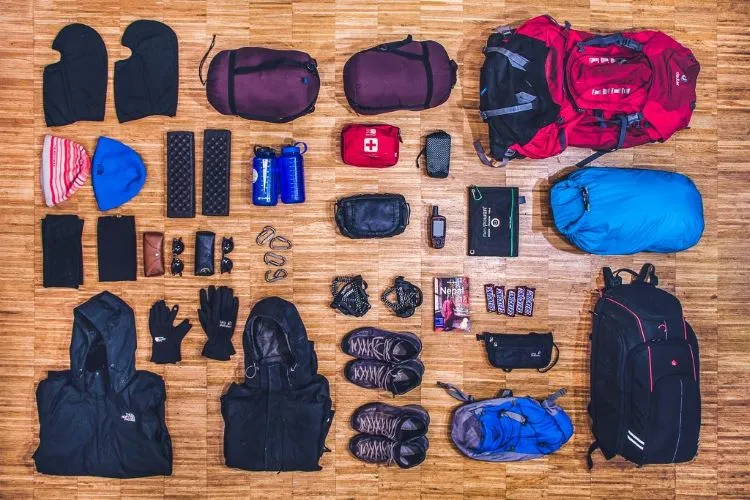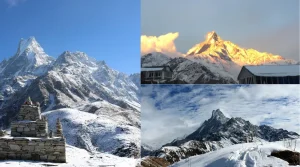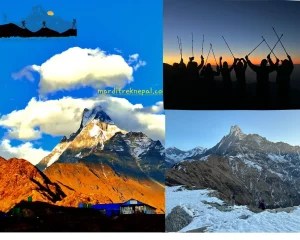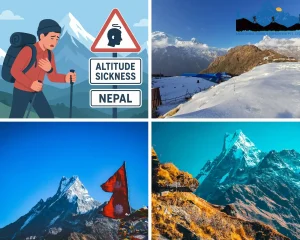If you are looking for a short, scenic trekking adventure in Nepal, the Mardi Himal Trek is a hidden pearl that combines adventure, tranquility, and breathtaking mountain views. Situated in the heart of the Annapurna region, this trek takes you through lush forests, charming villages, and high alpine landscapes that lead to the stunning Mardi Himal Base Camp. Whether you’re a seasoned hiker or a first-time adventurer, this guide offers all the Mardi Himal Trek Tips from the Mardi Himal Packing List to essential travel advice and the best time to trek Mardi Himal.
Mardi Himal Trek Overview
The Mardi Himal Trek is one of Nepal’s most rewarding short treks, typically completed in 4–6 days. The trail starts from Kande or Dhampus, winding through the rhododendron forests and traditional Gurung villages up to High Camp, to eventually Mardi Himal Base Camp at 4,500 meters.
From the base camp, trekkers are rewarded with majestic views of Machapuchare (Fishtail), Annapurna South, and Hiunchuli. Unlike other busy trails like the Annapurna Base Camp or Everest Base Camp treks, Mardi Himal remains peaceful and less crowded, making it perfect for those seeking a more intimate Himalayan experience.
This trek is ideal for those searching for the Mardi Himal trek for beginners, as the route is well-marked and doesn’t require advanced mountaineering skills. However, it’s still important to prepare physically and mentally to enjoy the journey to its fullest.
Mardi Himal Packing List
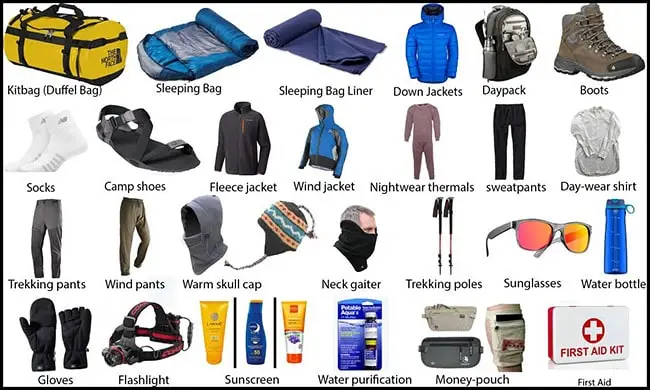
Packing smartly can make a huge difference in your trekking experience. Whether you’re an experienced trekker or a beginner, preparing the right gear for the Mardi Himal Trek ensures comfort, safety, and enjoyment throughout the journey. Here’s a detailed and practical Mardi Himal Packing List to help you get ready for this incredible Himalayan adventure.
1. Clothing
The weather on the Mardi Himal trail changes quickly, from warm forest trails to cold, windy ridgelines near Mardi Himal Base Camp. Dressing in layers is the best strategy, allowing you to adapt to varying temperatures.
Recommended Clothing:
- Base layer that wicks away the moisture: 2–3 sets (keeps sweat away, regulates body temperature on long hikes).
- Insulating fleece or down jacket: this will be essential for cold mornings and evenings at High Camp and Base Camp.
- Waterproof and windproof outer shell: Protects against unexpected rain or strong winds at higher altitudes.
- Trekking pants and shorts: comfortable, lightweight for both warm and cool conditions.
- Warm hat, gloves, and thermal socks: Crucial for keeping extremities warm in chilly weather.
- Lightweight t-shirts: quick-drying fabrics are better than cotton ones.
- Buff or neck gaiter: Useful for dust, sun, or cold protection.
Tip: Clothing made of synthetic or merino wool is preferable over cotton. Cotton holds moisture and takes much longer to dry.
2. Footwear
It is said that a good pair of shoes can make or break your trek. The uneven terrain, steps, stone pathways, and forest paths will require proper trekking footwear.
Recommended Footwear:
- Comfortable, broken-in trekking boots: Look for waterproof boots with good ankle support to prevent blisters and sprains.
- Lightweight sandals or slippers that are ideal for relaxing in teahouses after a whole day of trekking.
- Extra pairs of hiking socks: This will help keep your feet dry and blister-free. Wool or synthetic is ideal.
- Gaiters: Helpful during the monsoon or snow conditions to keep your boots dry.
Tip: Never commence a trek with new boots. Break them in well prior to the trip to avoid discomfort.
3. Gear & Accessories
Trekking gear makes your journey smoother and safer. While you don’t need to carry heavy expedition equipment, the right accessories make a big difference in convenience and comfort.
Essential Gear:
- Backpack 30–40L: A comfortable, adjustable backpack with a rain cover is ideal for carrying daily needs.
- Trekking poles: Not necessary, but very useful on the steep ascent and descent parts.
- Sleeping bag (suitable for -10°C): Nights at High Camp can be freezing, so a warm sleeping bag is vital.
- Headlamp with spare batteries: Essential for early morning hikes or power outages at lodges.
- Sunglasses and sunscreen: The high-altitude sun can be intense, even on cloudy days.
- Water bottle or hydration bladder: Hydrate properly; carry at least 2 L of water capacity.
- Quick-dry towel: lightweight, good for wiping away sweat or drying oneself after a quick wash.
- Map or trekking app: Even though the trail is marked, it’s good to have a navigation backup.
Tip: Keep electronics and valuables in waterproof pouches, especially during the monsoon season.
4. Personal Items
While trekking in remote mountain areas, access to shops is limited. Pack these essentials to ensure comfort and hygiene during your trek.
Personal Essentials:
- Basic first-aid kit: painkillers, blister plasters, antiseptic cream, plus any personal medication.
- Toiletries and wet wipes: Basic toiletries needed include a toothbrush, toothpaste, tissue paper, and biodegradable soap.
- Power bank and travel adapter: Most of the teahouses charge extra for electricity; having your own power source helps.
- Snacks and energy bars: Great for a quick energy boost during long trekking days.
- Lip balm and moisturizer: The cold, dry mountain air can cause both cracked lips and dry skin.
- Passport, permits, and some cash: Always carry the Annapurna Conservation Area Permit (ACAP), TIMS card, and some amount of local currency because ATMs are not available along the route.
- Reusable bags are always useful for keeping gear organized or carrying trash.
Tip: Pack personal hygiene products in reusable containers to minimize waste and protect the environment.
5. Optional but Useful Items
Depending on your trekking style and comfort needs, you can also consider bringing these extras:
- Lightweight camera or GoPro to capture stunning views of the Annapurna range.
- A diary or journal for documenting your trekking memories.
- Book or Kindle for relaxing evenings at the teahouse.
- Water purification tablets or a filter to refill bottles safely from local sources.
- Small padlock for locking your backpack or teahouse room.
6. Packing Tips for Mardi Himal Trek
Think of packing light yet smart for your preparation to the Mardi Himal trek. Attempt to carry only those things that you actually need.
- Pack light: target an overall backpack weight of around 8-10 kg.
- Layer wisely: The mountain climate varies — layering helps adjust to temperature changes easily.
- Organize by category: Use packing cubes or dry bags to keep gear neat and accessible.
- Weather protection: Always keep your rain gear and warm jacket near the top of your bag for easy access.
- Distribute weight properly: Heavier items should sit close to your back and centered for better balance.
Best Time to Trek Mardi Himal

Spring, starting from March to May, and autumn, starting from September to November, are considered to be the best time for trekking Mardi Himal. These two seasons offer the most pleasant weather with stable conditions and crystal-clear views of the Himalayan peaks, so they are preferred by most trekkers.
Spring Season (March to May)
Undoubtedly, spring is one of the most magical times to experience Mardi Himal Trek. The trails are vibrant with blooming rhododendron forests, lush greenery, and active wildlife. The days are warm and perfect for walking, though the mornings and evenings remain cool enough. Crystal-clear skies reveal incredible views of Mardi Himal Base Camp, Machapuchare-also known as Fishtail-and Annapurna South.
It is also an ideal season for photographers who would like to capture colorful landscapes of the mountains.
Temperature:
- Sub-montane zone (1,000–2,500 m): 15°C–25°C
- Higher region above 3,000 meters: 5°C–15°C
Why Trek in Spring:
- Blooming forests and colorful trails
- Moderate temperatures
- Excellent visibility of mountain peaks
Autumn Season (September to November)
Autumn is considered the best time to trek Mardi Himal for clear skies, pleasant temperatures, and a festive atmosphere across Nepal. The monsoon rains have cleared the dust and haze, leaving behind crisp air and stunning views of the snow-capped Himalayas.
This season also coincides with Nepal’s biggest festivals—Dashain and Tihar, offering trekkers a chance to experience local culture and traditions.
Temperature:
- Lower region: 10°C–20°C
- Higher region: 0°C–10°C
Why Trek in Autumn:
- Clear, stable weather and dry trails
- Ideal for panoramic photography
- Local village visits for rich cultural experiences
Winter Season (December to February)
Winter trekking to Mardi Himal Base Camp from December to February is possible but rather recommended for adequately prepared and experienced trekkers. The trails are quieter and more peaceful, offering a more private experience. However, expect cold nights and occasional snowfall above 3,000 meters. Proper winter gear and physical preparation are a must.
Temperature:
- Lower region: 5°C–15°C
- Higher region: -5°C to -10°C
Why Trek in Winter:
- Less crowded trails
- Peaceful teahouse experience
- Snow-covered landscapes
Monsoon Season (June to August)
Monsoon is not the best time to go because of heavy rainfall, leeches, and slippery paths. However, if you have nothing against rain and want to see green hills and quiet trails, this can also be an interesting adventure. Just make sure to take proper rain gear and waterproof clothes with you.
Temperature:
- Lower region: 20°C–30°C
- Higher region: 10°C–20°C
Why Trek in Monsoon:
- Fewer trekkers on the trail
- Green, lush landscape
- Ideal for solitude seekers (with proper gear)
Essential Tips for Trekking Mardi Himal

Here are some basic Mardi Himal Trek tips that will help make your adventure safe, comfortable, and memorable, especially if you are in search of how to prepare for the Mardi Himal trek or if you’re a beginner.
1. Train in Advance
Before the trek, get your body in shape through regular cardio exercises such as hiking, cycling, jogging, and stair climbing. Building endurance and leg strength helps you to walk for long hours with comfort at high altitudes. Fitness training should be initiated at least 3–4 weeks before the trip.
2. Acclimatize Properly
Even though Mardi Himal Base Camp (4,500 m) isn’t extremely high compared to other treks, altitude sickness can still affect anyone. Ascend gradually, take regular breaks, and stay hydrated. If you experience dizziness, nausea, or headaches, descend to a lower altitude immediately.
3. Hydrate
Drink at least 3-4 liters of water per day to keep your energy up and avoid AMS. Bring a refillable water bottle and use either purification tablets or a portable filter to refill in local sources. Avoid alcohol or excessive caffeine, as these will dehydrate you.
4. Hire a Local Guide
If you hire a guide for Mardi Himal, you support the local economy while adding valuable insight to your journey. A good guide will guarantee safety, handle logistics, and show you interesting facts about the culture, flora, and fauna. If you travel solo or this is the first time you do a high-altitude trek, then hiring a guide is almost essential.
5. Respect Local Culture
The trail passes through several Gurung and Magar villages, where people follow traditional customs and a simple lifestyle. Always greet locals with “Namaste,” ask before taking photographs, and dress modestly. Small gestures of respect go a long way in creating meaningful cultural exchanges.
6. Pack Light
A light backpack equals a more enjoyable trek. Carry only what’s necessary, as excess weight can tire you quickly. Refer to the Mardi Himal Packing List and keep your load under 10 kg. If needed, hire a porter to carry heavier gear, allowing you to enjoy the views freely.
The weather in the Himalayas can change suddenly. Keep a waterproof jacket, warm layers, and gloves with you at all times, especially while trekking near High Camp. Morning sunshine can turn into afternoon wind or fog within minutes, so be prepared for all conditions.
8. Book Accommodation Early
During peak seasons (spring and autumn), teahouses fill up quickly, especially in High Camp and Low Camp. Booking in advance or starting early in the day increases your chances of finding a good room. Some lodges also offer Wi-Fi and charging facilities for a small fee.
9. Carry Enough Cash
There are no ATMs along the Mardi Himal trail. Take sufficient Nepali rupees from Pokhara to cover food, accommodation, and extra expenses. Budget about NPR 3,000–4,000 per day, depending on your comfort level and choices.
10. Get Travel Insurance
Always trek with comprehensive insurance that covers 5,000-meter-high trekking and emergency helicopter evacuation. This is one of the most crucial Mardi Himal Trek Tips because bad weather conditions or altitude sickness might require quick evacuation.
11. Begin Each Day Early
Begin your trek early in the morning to make the most of daylight and clear skies. Afternoon clouds often obscure mountain views, so early risers enjoy the best photo opportunities and calm trails.
12. Enjoy the Journey, Not Just the Destination
While reaching Mardi Himal Base Camp is a highlight, remember that every step through the rhododendron forests and traditional villages is part of the experience. Slow down, interact with locals, and soak in the beauty of the Annapurna region.
Conclusion
The Mardi Himal Trek is one of Nepal’s most beautiful yet accessible trekking adventures. From serene forest trails to breathtaking views of Mardi Himal Base Camp, every step offers something memorable. By following the right Mardi Himal Trek Tips, packing wisely with the help of the Mardi Himal Packing List, and knowing the best time to trek Mardi Himal, you can make the most of this adventure.
Whether you’re looking for a peaceful escape into nature or wondering how to prepare for the Mardi Himal trek, this route promises an unforgettable experience that captures the essence of Nepal’s Himalayas. So lace up your boots, grab your backpack, and let the Mardi Himal Guide lead you toward an incredible mountain journey.
FAQs
How to prepare for the Mardi Himal trek?
Prioritize logistics, equipment, packing, and physical fitness in order to get ready for the Mardi Himal trek. On a physical level, practice hiking with a weighted backpack and boost endurance with strength and cardio training. Make sure you have travel insurance, hire a guide, and obtain the necessary permits. Bring along layers of clothes, sunscreen, and any gear you’ll need, like a sleeping bag and a flashlight.
Is Mardi Himal Trek for beginners?
The Mardi Himal Trek is suitable for novices, but because of its steep ascents and descents, it requires a moderate level of preparation and fitness. Beginners should be ready to navigate and hike for four to six hours every day.
How to make your body fit for trekking?
Strengthen your legs, core, and upper body in addition to cardiovascular exercises like walking and jogging to get ready for trekking. Stretching and other flexibility exercises should be incorporated into your workouts as you gradually increase their duration and intensity.
Is Mardi Trek risky?
Yes, the Mardi Trek can be risky due to factors like unmarked trails, slick and steep terrain, the potential for altitude sickness, and the chance of getting lost, especially if you don’t have enough planning or a guide. However, by following a guide, making travel plans, and avoiding the monsoon and winter seasons, the risks can be significantly decreased.
How long does it take to do the Mardi Himal Trek?
Depending on your route, the Mardi Himal walk can take anywhere from three to eight days, though five to seven days is the most typical. About 41–45 kilometers (25–28 miles) make up the entire trekking distance.


